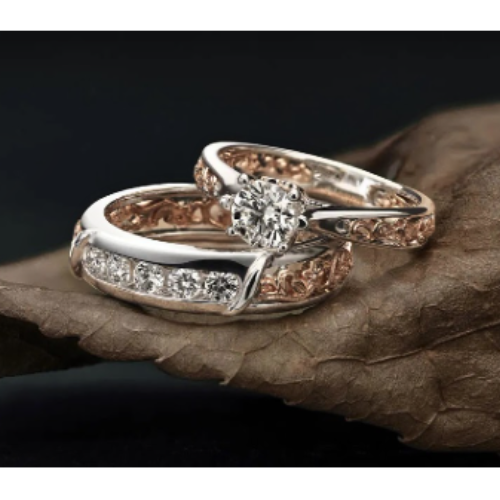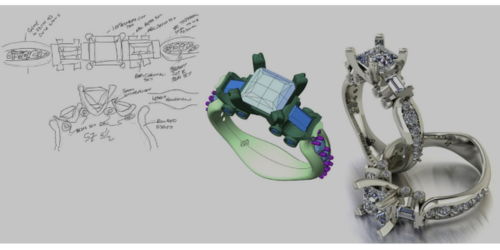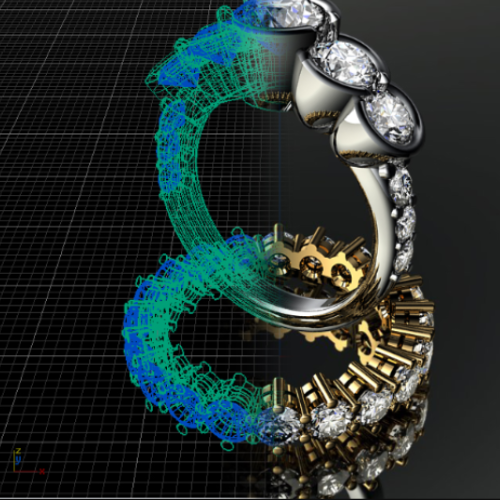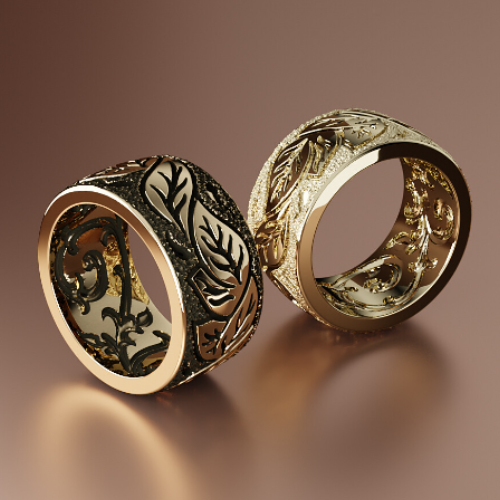
Have you ever wondered how involved you can be in the bespoke jewellery creation process? Whether you’re dreaming of a one-of-a-kind engagement ring or a statement piece that reflects your personality, bespoke jewellery offers a unique opportunity to bring your vision to life. Let’s explore the fascinating world of custom jewellery design and discover how you can play an active role in creating a truly special piece.
Understanding Bespoke Jewellery: Your Vision, Their Expertise
Bespoke jewellery is the pinnacle of personalization in the world of adornments. Unlike off-the-shelf pieces or even made-to-order items, bespoke jewellery starts with your idea and is brought to life through a collaborative process with skilled artisans.
When you choose to create custom jewellery, you’re not just picking from pre-designed options. You’re embarking on a journey where every detail, from the metal choice to the stone setting, is tailored to your preferences. This level of customization ensures that your piece isn’t just beautiful – it’s a reflection of your story and style.
“Bespoke jewellery is more than a product; it’s a deeply personal experience that results in a wearable piece of art.” – Master Jeweller
Why opt for bespoke over ready-made jewellery? Here are a few compelling reasons:
- Unparalleled uniqueness: Your piece will be one-of-a-kind, just like you.
- Perfect fit: Custom-designed jewellery can accommodate unique body shapes and preferences.
- Emotional value: The involvement in the creation process adds sentimental worth to the piece.
- Quality control: You have a say in the materials and craftsmanship used.
- Investment potential: Bespoke pieces often hold or increase in value over time.
The bespoke jewellery creation process also allows you to honour traditions or create new ones. For instance, you might incorporate a family heirloom stone into a modern setting, blending past and present. Or you could design a piece that celebrates a personal milestone, creating a new tradition for future generations.
The Stages of Bespoke Jewellery Creation: Your Role in Each Step
1. Initial Consultation: Sharing Your Vision
The bespoke jewellery creation process begins with a conversation. This is your chance to share your dreams, inspirations, and ideas with your jeweller. To make the most of this initial meeting:
- Gather inspiration: Collect images, sketches, or even objects that represent your style.
- Consider your lifestyle: Think about how and when you’ll wear the piece.
- Set a budget: Be upfront about your financial parameters to guide the design process.
- Reflect on symbolism: Consider any meaningful elements you’d like to incorporate.
Questions to ask your jeweller:
- What’s your experience with my type of design?
- Can you show me examples of similar pieces you’ve created?
- How long will the entire process take?
- What kind of warranty or aftercare do you offer?
- How do you source your materials?
Remember, effective communication is key. Don’t be afraid to express your ideas, even if they seem unconventional. The best jewellers thrive on creative challenges and will work with you to refine your concept into a feasible design.
During this stage, you might also discuss the possibility of using alternative materials. For example, if you’re interested in a diamond look but want a more budget-friendly option, your jeweller might suggest moissanite or lab-grown diamonds. They can explain the pros and cons of each choice, helping you make an informed decision.
2. Design Development: Collaborating on Sketches
Once your jeweller understands your vision, they’ll begin translating it into tangible designs. This stage is where your involvement can really shine. You’ll typically see two types of renderings:
- Technical drawings: These precise sketches show the structural details of your piece.
- Artistic renderings: More visually appealing, these give you a better idea of the final look.
Your role here is to provide honest feedback. Don’t hesitate to request changes or ask questions. The design phase is iterative, and each revision brings you closer to your perfect piece.

Tips for providing effective feedback:
- Be specific about what you like and dislike
- Ask to see different angles or views if needed
- Consider how the piece will look when worn
- Think about how the design aligns with your original vision
During this phase, you might explore various design elements:
- Setting styles: Prong, bezel, tension, or flush settings each have their own look and benefits.
- Metal finishes: Polished, matte, hammered, or brushed finishes can dramatically change a piece’s appearance.
- Accent details: Consider elements like milgrain edges, filigree work, or hidden gemstones.
Remember, this is your chance to fine-tune every aspect of your jewellery. Don’t rush this stage – take time to consider each element carefully.
3. Material Selection: Making Informed Choices
Choosing materials is where the bespoke jewellery creation process gets tactile. You’ll be presented with options for metals and gemstones, each with its own characteristics and appeal.
Precious Metals Comparison:
| Metal | Pros | Cons |
| Gold (Various Karats) | Lustrous, traditional, variety of colours | Softer at higher karats, can be expensive |
| Platinum | Durable, hypoallergenic, holds stones securely | Heavier, more expensive than gold |
| Silver | Affordable, bright lustre | Requires more maintenance, can tarnish |
| Palladium | Lightweight, durable, hypoallergenic | Less common, limited design options |
When it comes to gemstones, the famous 4 Cs (Cut, Color, Clarity, and Carat) are just the beginning. Consider factors like durability for everyday wear, the stone’s meaning or birthstone significance, and how it complements your skin tone.
Beyond diamonds: While diamonds are popular, there’s a world of colourful gemstones to explore:
- Sapphires: Available in a rainbow of colours, not just blue
- Emeralds: Lush green, but require careful setting due to their softer nature
- Rubies: Vibrant red, symbolising passion and love
- Opals: Unique play-of-colour effect, but require gentle care
Ethical sourcing is increasingly important in jewellery creation. Don’t hesitate to ask about the origin of materials. Many jewellers now offer traceable gemstones and recycled metals, allowing you to create a piece that’s not only beautiful but also responsible.
4. 3D Modeling and Prototyping: Seeing Your Jewellery Come to Life
Modern technology has revolutionised the bespoke jewellery creation process. Computer-Aided Design (CAD) allows jewellers to create detailed 3D models of your piece. This step is crucial because it lets you visualise the design in a way that 2D sketches simply can’t match.
The CAD process typically involves:
- Creating a basic 3D model based on the approved 2D design
- Refining the model with precise measurements and details
- Rendering the model to show how different metals and stones will look
- Making adjustments based on your feedback
Once the CAD model is approved, many jewellers offer 3D printed prototypes. This physical model, usually made of resin, gives you a tangible sense of the size, proportions, and overall feel of your jewellery. It’s your last chance to make significant changes before production begins.
What to look for in a prototype:
- Overall proportions and scale
- Comfort and wearability
- Details like stone placement and engraving positioning
- How the piece sits on your hand, neck, or ear
Some jewellers even offer virtual try-on experiences using augmented reality technology. This can be especially helpful if you’re designing your piece remotely.

5. Craftsmanship in Action: Witnessing the Making
One of the most exciting aspects of bespoke jewellery creation is the opportunity to see your piece being made. While not all jewellers offer this, many are happy to show you parts of the process. You might witness:
- Metal casting: Molten metal being poured into a mould
- Stone setting: Precise placement of gemstones
- Hand engraving: Adding intricate details or personal messages
- Polishing and finishing: Bringing out the shine and lustre of your piece
Watching these steps gives you a deep appreciation for the skill involved in creating your piece. It’s a reminder that bespoke jewellery is as much about the journey as the final product.
The lost wax casting process: Many custom pieces are created using this ancient technique:
- A wax model of your jewellery is created
- The wax is encased in a plaster-like material
- The wax is melted out, leaving a hollow mould
- Molten metal is poured into the mould
- Once cooled, the plaster is broken away, revealing your piece
This process allows for intricate designs that would be difficult or impossible to create through other methods.
6. Final Touches: Ensuring Perfection
As your jewellery nears completion, your involvement shifts to quality control. Here’s what to look for:
- Symmetry and balance: Ensure the design looks harmonious from all angles.
- Stone security: Gems should be firmly set with no wobble.
- Finish quality: Look for a consistent polish with no scratches or blemishes.
- Comfort: The piece should feel good when worn.
- Hallmarks: Check for quality stamps indicating metal purity.
This is also the time for any final personalizations, like engravings. Many couples choose to add dates, initials, or meaningful phrases to their bespoke wedding bands, creating an extra layer of sentimentality.
Popular engraving options:
- Wedding date in Roman numerals
- Coordinates of a special location
- A line from a favourite poem or song
- Names or initials in a special font
Remember, engravings don’t have to be visible to others. Some people choose to place them on the inside of a ring band for a secret, personal touch.

Balancing Involvement and Expertise: When to Step Back
While the bespoke jewellery creation process invites your participation, it’s important to recognize when to defer to your jeweller’s expertise. These professionals have years of training and experience in both design and technical aspects of jewellery making.
For example, while you might have a clear vision for a ring design, your jeweller might suggest modifications to ensure the setting is secure or the piece is durable for everyday wear. Trust their guidance on technical matters – their goal is to create a piece that’s not only beautiful but also practical and long-lasting.
Areas where professional expertise is crucial:
- Stone setting techniques: The right setting ensures your gems are secure and showcased beautifully.
- Metal thickness: Too thin, and your piece may warp over time; too thick, and it might be uncomfortably heavy.
- Structural integrity: Certain designs may look great on paper but need adjustments to be wearable and durable.
- Finishing techniques: The right polish or texture can make a huge difference in the final look.
Remember, a good jeweller will explain their recommendations and work with you to find solutions that maintain your vision while ensuring the piece’s quality and longevity.
The Emotional Journey of Bespoke Jewellery Creation
Creating custom jewellery is as much an emotional experience as it is a physical one. Many clients form strong bonds with their jewellers during the process. This relationship is built on trust, communication, and shared excitement for the project.
It’s normal to feel a range of emotions throughout the creation process:
- Excitement as you see your ideas take shape
- Anxiety when making important decisions
- Impatience as you wait for each stage to complete
- Joy and pride when you finally hold your finished piece
Remember, these feelings are part of what makes bespoke jewellery so special. Each emotion becomes woven into the story of your piece, adding to its personal significance.
Emotional milestones in the bespoke process:
- The “aha” moment when you and your jeweller land on the perfect design
- Seeing your piece in 3D for the first time
- Choosing your centre stone or main materials
- The anticipation of the final reveal
Many clients report that the emotional investment in their bespoke piece makes it far more meaningful than any off-the-shelf jewellery they’ve purchased before.
Beyond Creation: Your Ongoing Relationship with Bespoke Jewellery
The journey doesn’t end when you receive your finished piece. Bespoke jewellery often requires specific care to maintain its beauty and integrity. Your jeweller should provide detailed care instructions tailored to your piece’s materials and design.
General care tips for bespoke jewellery:
- Store pieces separately to avoid scratches
- Remove jewellery before swimming, bathing, or using harsh chemicals
- Have your pieces professionally cleaned and inspected annually
- Consider insurance for high-value items
Many people find that their first bespoke experience sparks a passion for custom jewellery. You might consider:
- Creating matching pieces to form a set
- Designing seasonal or occasion-specific jewellery
- Incorporating heirloom stones into new designs
Your relationship with The Jewellery Mechanic can extend far beyond your initial project, turning them into a trusted partner for all your future jewellery needs. Some jewellers offer lifetime warranties or upgrade programs, allowing you to evolve your piece as your style or circumstances change.
Is Bespoke Jewellery Right for You? Weighing the Pros and Cons
While the bespoke jewellery creation process is rewarding, it’s not for everyone. Consider these factors:
Pros:
- Unparalleled customization
- High-quality materials and craftsmanship
- A meaningful creation experience
- Potential for better value in the long term
- Ability to create exactly what you want
Cons:
- Higher upfront cost compared to ready-made pieces
- Longer wait times for completion
- Requires more decision-making and involvement
- May be overwhelming for those who prefer simplicity
Ultimately, the decision to go bespoke depends on how much you value uniqueness and personal involvement in your jewellery. It’s an investment not just of money, but of time and emotional energy.
Who bespoke jewellery is perfect for:
- Those with unique style preferences not easily found in stores
- Individuals looking to commemorate special moments or milestones
- People who enjoy the creative process and storytelling through jewellery
- Anyone with specific fit requirements or metal sensitivities
If you’re still unsure, consider starting with a smaller project, like a simple pendant or pair of earrings, to get a feel for the bespoke process.
Technology’s Role in Bespoke Jewellery Creation
Advancements in technology have made the bespoke jewellery creation process more accessible and efficient than ever. Some cutting-edge options include:
- Virtual consultations: Design your piece from anywhere in the world
- Augmented reality try-ons: See how your design looks on you before it’s made
- Advanced 3D printing: Create intricate designs that were previously impossible to manufacture
- Laser engraving: Achieve incredibly detailed and precise personalization
- Digital gemstone mapping: Optimise stone placement for maximum brilliance
These technologies enhance the creation process without diminishing the artisanal skills that make bespoke jewellery special. They allow for greater precision, more design possibilities, and a smoother collaborative process between you and your jeweller.
Ethical and Sustainable Practices in Bespoke Jewellery
The bespoke jewellery creation process offers a unique opportunity to ensure your piece aligns with your values. Many jewellers now offer:
- Conflict-free diamonds and gemstones
- Recycled or ethically sourced metals
- Low-impact or traditional manufacturing techniques
- Transparent supply chains
By choosing these options, you’re not just creating a beautiful piece of jewellery – you’re supporting responsible practices in the industry.
Sustainable options in bespoke jewellery:
- Lab-grown diamonds: Chemically identical to mined diamonds but with a smaller environmental footprint
- Vintage or recycled stones: Reusing existing gems reduces the demand for new mining
- Fair-mined gold: Supports small-scale miners and ensures ethical working conditions
When discussing ethical options with your jeweller, don’t be afraid to ask for certifications or documentation. Reputable jewellers will be happy to provide information about their sourcing practices.
Celebrating Your Creation: The Final Reveal
After weeks or months of collaboration, the day finally arrives to see your finished piece. This moment is often emotional, as you see your vision transformed into reality.
Many jewellers make this reveal a special event, presenting your piece in beautiful packaging and walking you through its features. Take time to appreciate every detail and, if possible, document this moment. The story of your jewellery’s creation adds to its meaning and value.
Tips for the final reveal:
- Bring a trusted friend or family member to share the moment
- Ask your jeweller to explain any special features or techniques used
- Take photos or videos to capture your initial reaction
- Try on the piece and see how it looks in different lights
Conclusion: Your Role in the Bespoke Jewellery Creation Process
So, how involved can you be in the bespoke jewellery creation process? The answer is: as involved as you want to be. From the initial spark of an idea to the final polish, your input and decisions shape the outcome. Whether you’re hands-on at every stage or prefer to give broad guidelines and trust your jeweller’s expertise, the result is a piece of jewellery that’s uniquely yours.
Remember, the goal of bespoke jewellery isn’t just to create an object – it’s to create a story, a memory, and a legacy. By engaging in this process, you’re not just a customer; you’re a co-creator, working alongside The Jewellery Mechanic to bring a piece of art into the world.
Whether you’re considering an engagement ring, a special anniversary gift, or simply a treat for yourself, the bespoke jewellery creation process offers an unparalleled opportunity to create something truly meaningful. It’s a journey of creativity, craftsmanship, and personal expression – one that results in a treasure you’ll cherish for a lifetime.
